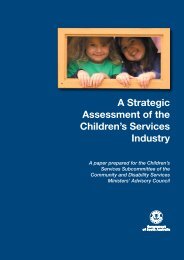Global Study On Child Poverty And Disparities (PDF) - Social Policy ...
Global Study On Child Poverty And Disparities (PDF) - Social Policy ...
Global Study On Child Poverty And Disparities (PDF) - Social Policy ...
Create successful ePaper yourself
Turn your PDF publications into a flip-book with our unique Google optimized e-Paper software.
100,000<br />
90,000<br />
80,000<br />
70,000<br />
60,000<br />
50,000<br />
40,000<br />
30,000<br />
20,000<br />
10,000<br />
0<br />
Figure 1.8: Monthly per capita household<br />
expenditure, 2006<br />
Total Expenditure<br />
Total Less Food <strong>And</strong> Transport<br />
Torba Sanma Tafea Malampa Total Rural Penama Shefa Luganville Total Port<br />
Urban Vila<br />
Source: Based on data from ADB, UNDP and GOV 2006;<br />
VNSO.<br />
Figure 1.10: Trends in price indices, 2005 to 2010<br />
(2005 = 1)<br />
1.35<br />
1.3<br />
1.25<br />
1.2<br />
1.15<br />
1.1<br />
1.05<br />
1<br />
2005<br />
2006<br />
Source: VNSO, 2010<br />
All Food Transport<br />
2007<br />
2008<br />
2009<br />
2010<br />
45%<br />
40%<br />
35%<br />
30%<br />
25%<br />
20%<br />
15%<br />
10%<br />
5%<br />
0<br />
Another way of looking at this is to consider the<br />
share of total cash expenditures on food and<br />
transport. Figure 1.9 shows that urban households<br />
in Vanuatu allocate more than 35 per cent of<br />
their total expenditures to these two categories,<br />
compared with less than 25 per cent in most rural<br />
provinces.<br />
Figure 1.9: Food and transport share of total<br />
expenditures by location, 2006 (%)<br />
Food<br />
Transport<br />
Malampa Penama Torba Total Rural Sanma Tafea Shefa Luganville Total Port<br />
Urban Vila<br />
Source: Based on data from ADB, UNDP and GOV 2006;<br />
VNSO<br />
The relatively high share of total expenditure<br />
dedicated to cash expenditures on food and<br />
transport in urban areas in Vanuatu is likely to<br />
be a significant concern, given trends in inflation<br />
since the 2006. HIES. Figure 1.10 shows trends<br />
in the overall Consumer Price Index and the price<br />
indices for food and transport, with March 2005<br />
set as the base. It is apparent that since 2006<br />
food prices have increased at a much faster rate<br />
than prices generally, and the same has been true<br />
for transport prices since 2008. As a result, the<br />
increase in food prices over this period has been<br />
nearly 50 per cent higher than the increase in the<br />
Consumer Price Index. This is likely to have had<br />
the largest impact on urban households, who are<br />
much more reliant on market purchases.<br />
Macroeconomic strategies and<br />
resource allocation<br />
The Government of Vanuatu’s 2009 strategy<br />
document Planning Long, Acting Short outlines<br />
the most recent policy priorities and strategies,<br />
which include macroeconomic and governance<br />
priorities as well as strategies focusing on<br />
employment, education and health. In terms of<br />
macroeconomic policy, the Government’s priority<br />
is to achieve responsible macroeconomic and<br />
fiscal management, including implementing the<br />
New Development Budget by 2010 to better align<br />
resources with priorities, strengthening the legal<br />
regime governing the appropriation and use of<br />
public funds, and maintaining payroll costs at a<br />
manageable level. 10<br />
Together with Planning Long, Acting Short,<br />
the priorities and action agenda (PAA) An<br />
Educated, Healthy and Wealthy Vanuatu 2006-<br />
2015 (Government of Vanuatu 2006a) sets the<br />
government’s 10-year policy priorities. The initial<br />
PAA was formulated in 2003 with five priority<br />
areas, and was later expanded to cover seven<br />
priorities: (1) private sector development and<br />
employment creation; (2) macroeconomic stability<br />
and equitable growth; (3) good governance<br />
and public sector reform; (4) primary sector<br />
development (natural resources and the<br />
environment); (5) improved provision of basic<br />
services, especially in rural areas; (6) education<br />
and human resources development; and<br />
(7) economic infrastructure and support. This<br />
policy also emphasizes expanding economic<br />
opportunities and economic infrastructure.<br />
Overall, the main policy strategy in Vanuatu<br />
is focused on increasing private investment<br />
10 In 2006, wages and salaries absorbed more than 50 per cent of total government expenditures,<br />
the highest level in the Pacific (Amosa, Narayan, Naz and Pandaram 2009). In the key<br />
service delivery areas of health and education, these proportions are even higher.<br />
26
















